Taxation Law: Income Recognition Mechanisms and Treatment of Expenses
VerifiedAdded on 2023/06/07
|9
|2796
|54
AI Summary
This article discusses the factors impacting the choice of income recognition method, the treatment of expenses and outgoings incurred by Ruby Pty Ltd in the real estate business, and the relevance of the distinction between cash and accrual. It also provides relevant case laws and sections of ITAA 1997 for tax deductions.
Contribute Materials
Your contribution can guide someone’s learning journey. Share your
documents today.
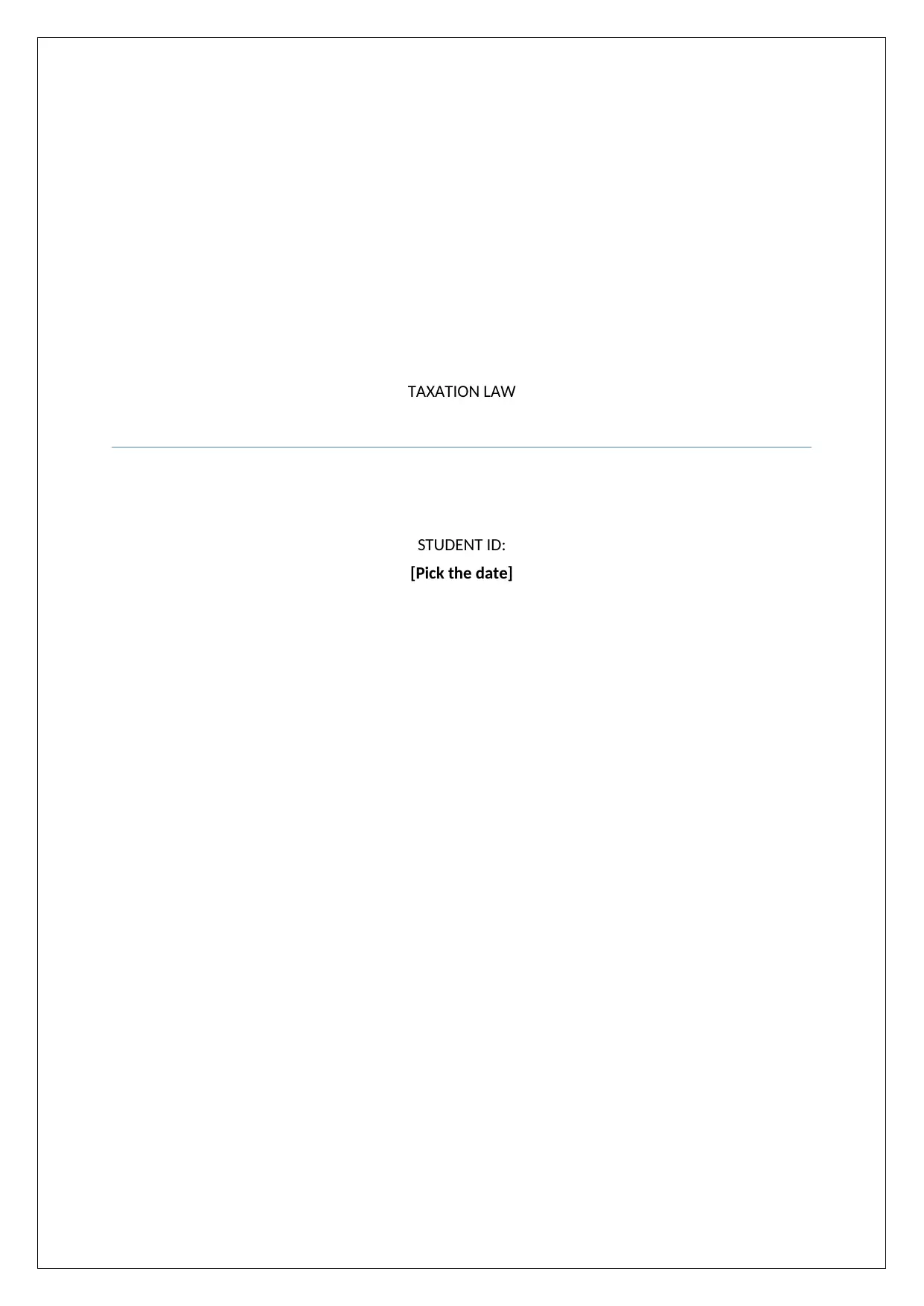
TAXATION LAW
STUDENT ID:
[Pick the date]
STUDENT ID:
[Pick the date]
Secure Best Marks with AI Grader
Need help grading? Try our AI Grader for instant feedback on your assignments.
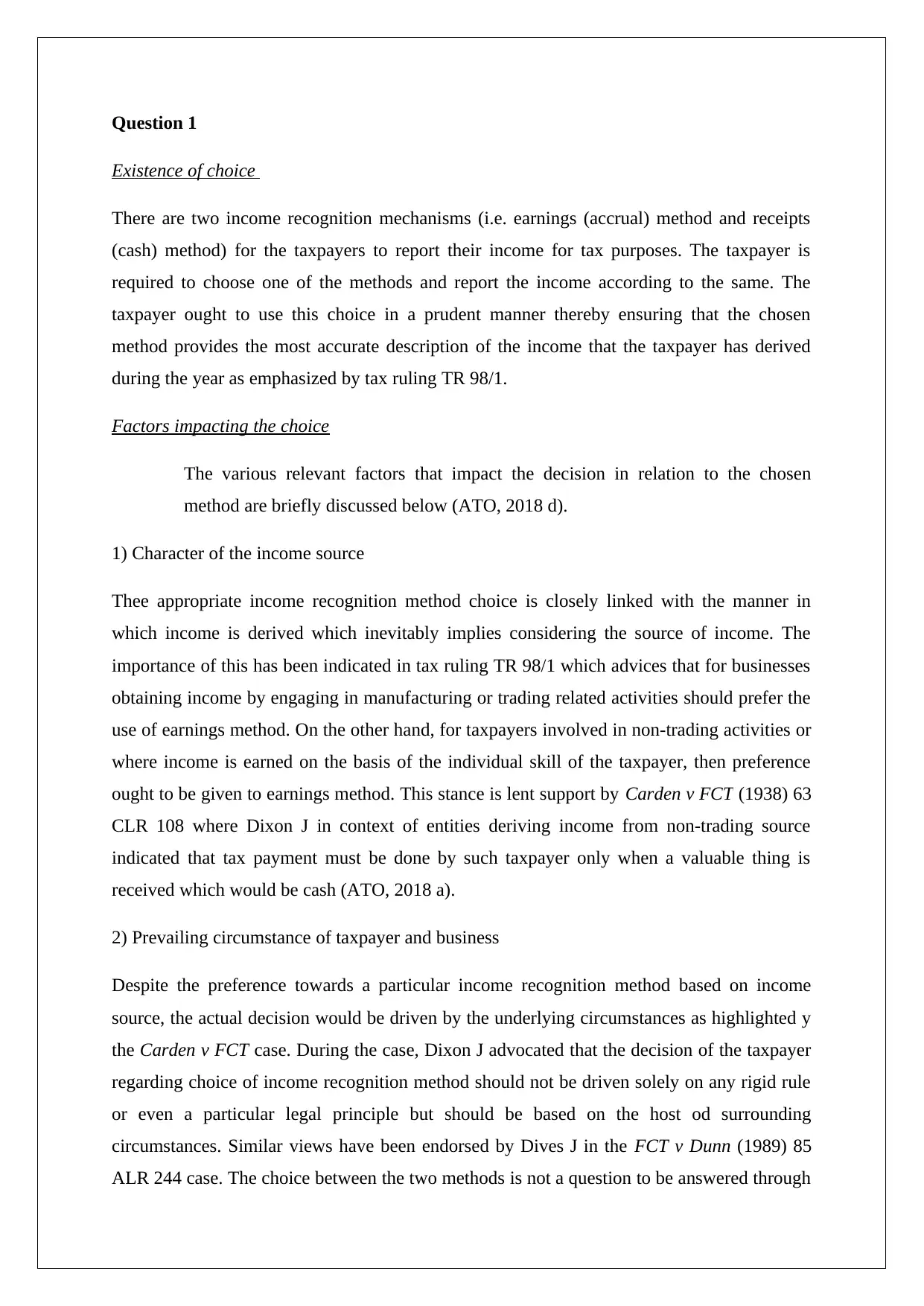
Question 1
Existence of choice
There are two income recognition mechanisms (i.e. earnings (accrual) method and receipts
(cash) method) for the taxpayers to report their income for tax purposes. The taxpayer is
required to choose one of the methods and report the income according to the same. The
taxpayer ought to use this choice in a prudent manner thereby ensuring that the chosen
method provides the most accurate description of the income that the taxpayer has derived
during the year as emphasized by tax ruling TR 98/1.
Factors impacting the choice
The various relevant factors that impact the decision in relation to the chosen
method are briefly discussed below (ATO, 2018 d).
1) Character of the income source
Thee appropriate income recognition method choice is closely linked with the manner in
which income is derived which inevitably implies considering the source of income. The
importance of this has been indicated in tax ruling TR 98/1 which advices that for businesses
obtaining income by engaging in manufacturing or trading related activities should prefer the
use of earnings method. On the other hand, for taxpayers involved in non-trading activities or
where income is earned on the basis of the individual skill of the taxpayer, then preference
ought to be given to earnings method. This stance is lent support by Carden v FCT (1938) 63
CLR 108 where Dixon J in context of entities deriving income from non-trading source
indicated that tax payment must be done by such taxpayer only when a valuable thing is
received which would be cash (ATO, 2018 a).
2) Prevailing circumstance of taxpayer and business
Despite the preference towards a particular income recognition method based on income
source, the actual decision would be driven by the underlying circumstances as highlighted y
the Carden v FCT case. During the case, Dixon J advocated that the decision of the taxpayer
regarding choice of income recognition method should not be driven solely on any rigid rule
or even a particular legal principle but should be based on the host od surrounding
circumstances. Similar views have been endorsed by Dives J in the FCT v Dunn (1989) 85
ALR 244 case. The choice between the two methods is not a question to be answered through
Existence of choice
There are two income recognition mechanisms (i.e. earnings (accrual) method and receipts
(cash) method) for the taxpayers to report their income for tax purposes. The taxpayer is
required to choose one of the methods and report the income according to the same. The
taxpayer ought to use this choice in a prudent manner thereby ensuring that the chosen
method provides the most accurate description of the income that the taxpayer has derived
during the year as emphasized by tax ruling TR 98/1.
Factors impacting the choice
The various relevant factors that impact the decision in relation to the chosen
method are briefly discussed below (ATO, 2018 d).
1) Character of the income source
Thee appropriate income recognition method choice is closely linked with the manner in
which income is derived which inevitably implies considering the source of income. The
importance of this has been indicated in tax ruling TR 98/1 which advices that for businesses
obtaining income by engaging in manufacturing or trading related activities should prefer the
use of earnings method. On the other hand, for taxpayers involved in non-trading activities or
where income is earned on the basis of the individual skill of the taxpayer, then preference
ought to be given to earnings method. This stance is lent support by Carden v FCT (1938) 63
CLR 108 where Dixon J in context of entities deriving income from non-trading source
indicated that tax payment must be done by such taxpayer only when a valuable thing is
received which would be cash (ATO, 2018 a).
2) Prevailing circumstance of taxpayer and business
Despite the preference towards a particular income recognition method based on income
source, the actual decision would be driven by the underlying circumstances as highlighted y
the Carden v FCT case. During the case, Dixon J advocated that the decision of the taxpayer
regarding choice of income recognition method should not be driven solely on any rigid rule
or even a particular legal principle but should be based on the host od surrounding
circumstances. Similar views have been endorsed by Dives J in the FCT v Dunn (1989) 85
ALR 244 case. The choice between the two methods is not a question to be answered through
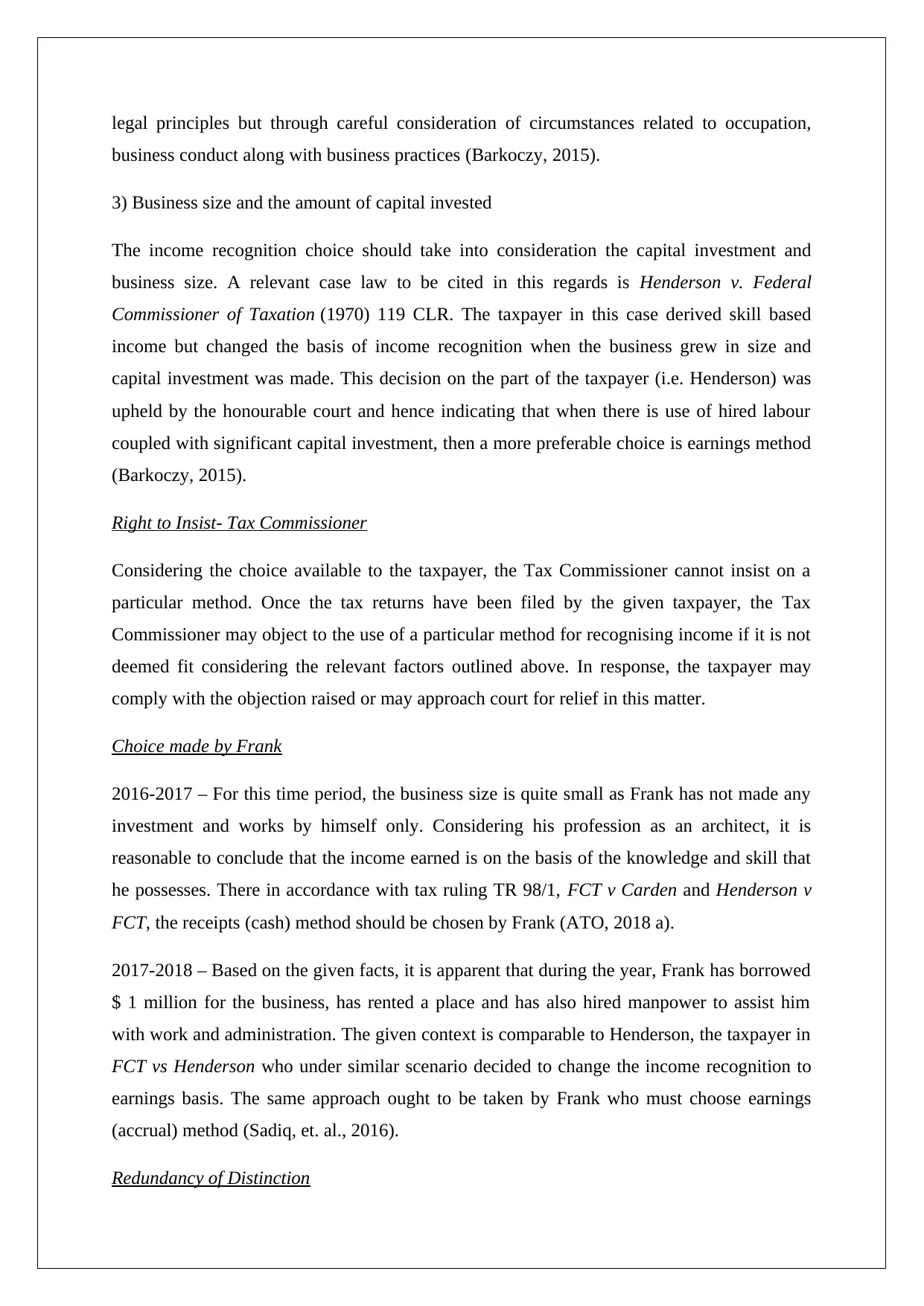
legal principles but through careful consideration of circumstances related to occupation,
business conduct along with business practices (Barkoczy, 2015).
3) Business size and the amount of capital invested
The income recognition choice should take into consideration the capital investment and
business size. A relevant case law to be cited in this regards is Henderson v. Federal
Commissioner of Taxation (1970) 119 CLR. The taxpayer in this case derived skill based
income but changed the basis of income recognition when the business grew in size and
capital investment was made. This decision on the part of the taxpayer (i.e. Henderson) was
upheld by the honourable court and hence indicating that when there is use of hired labour
coupled with significant capital investment, then a more preferable choice is earnings method
(Barkoczy, 2015).
Right to Insist- Tax Commissioner
Considering the choice available to the taxpayer, the Tax Commissioner cannot insist on a
particular method. Once the tax returns have been filed by the given taxpayer, the Tax
Commissioner may object to the use of a particular method for recognising income if it is not
deemed fit considering the relevant factors outlined above. In response, the taxpayer may
comply with the objection raised or may approach court for relief in this matter.
Choice made by Frank
2016-2017 – For this time period, the business size is quite small as Frank has not made any
investment and works by himself only. Considering his profession as an architect, it is
reasonable to conclude that the income earned is on the basis of the knowledge and skill that
he possesses. There in accordance with tax ruling TR 98/1, FCT v Carden and Henderson v
FCT, the receipts (cash) method should be chosen by Frank (ATO, 2018 a).
2017-2018 – Based on the given facts, it is apparent that during the year, Frank has borrowed
$ 1 million for the business, has rented a place and has also hired manpower to assist him
with work and administration. The given context is comparable to Henderson, the taxpayer in
FCT vs Henderson who under similar scenario decided to change the income recognition to
earnings basis. The same approach ought to be taken by Frank who must choose earnings
(accrual) method (Sadiq, et. al., 2016).
Redundancy of Distinction
business conduct along with business practices (Barkoczy, 2015).
3) Business size and the amount of capital invested
The income recognition choice should take into consideration the capital investment and
business size. A relevant case law to be cited in this regards is Henderson v. Federal
Commissioner of Taxation (1970) 119 CLR. The taxpayer in this case derived skill based
income but changed the basis of income recognition when the business grew in size and
capital investment was made. This decision on the part of the taxpayer (i.e. Henderson) was
upheld by the honourable court and hence indicating that when there is use of hired labour
coupled with significant capital investment, then a more preferable choice is earnings method
(Barkoczy, 2015).
Right to Insist- Tax Commissioner
Considering the choice available to the taxpayer, the Tax Commissioner cannot insist on a
particular method. Once the tax returns have been filed by the given taxpayer, the Tax
Commissioner may object to the use of a particular method for recognising income if it is not
deemed fit considering the relevant factors outlined above. In response, the taxpayer may
comply with the objection raised or may approach court for relief in this matter.
Choice made by Frank
2016-2017 – For this time period, the business size is quite small as Frank has not made any
investment and works by himself only. Considering his profession as an architect, it is
reasonable to conclude that the income earned is on the basis of the knowledge and skill that
he possesses. There in accordance with tax ruling TR 98/1, FCT v Carden and Henderson v
FCT, the receipts (cash) method should be chosen by Frank (ATO, 2018 a).
2017-2018 – Based on the given facts, it is apparent that during the year, Frank has borrowed
$ 1 million for the business, has rented a place and has also hired manpower to assist him
with work and administration. The given context is comparable to Henderson, the taxpayer in
FCT vs Henderson who under similar scenario decided to change the income recognition to
earnings basis. The same approach ought to be taken by Frank who must choose earnings
(accrual) method (Sadiq, et. al., 2016).
Redundancy of Distinction
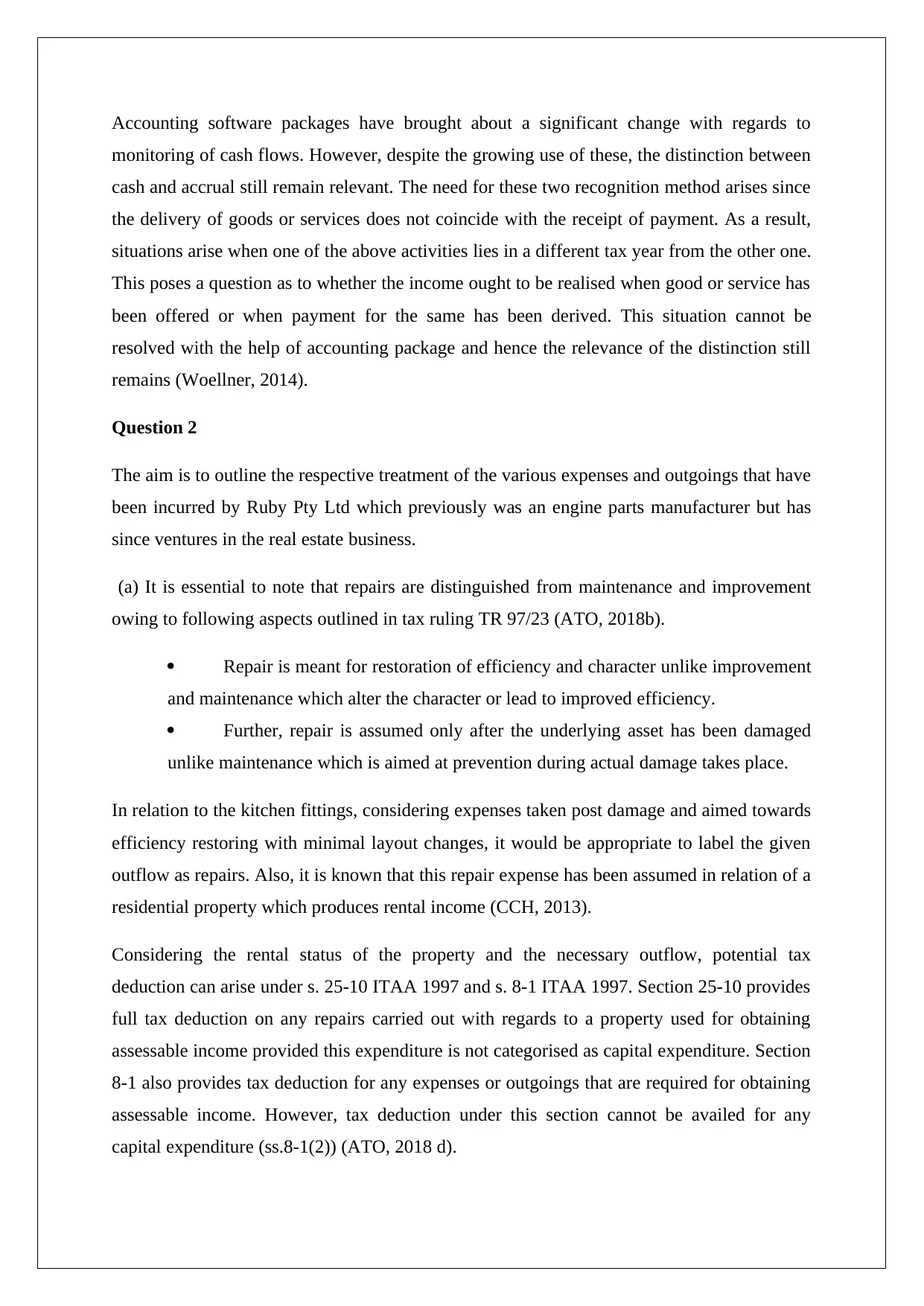
Accounting software packages have brought about a significant change with regards to
monitoring of cash flows. However, despite the growing use of these, the distinction between
cash and accrual still remain relevant. The need for these two recognition method arises since
the delivery of goods or services does not coincide with the receipt of payment. As a result,
situations arise when one of the above activities lies in a different tax year from the other one.
This poses a question as to whether the income ought to be realised when good or service has
been offered or when payment for the same has been derived. This situation cannot be
resolved with the help of accounting package and hence the relevance of the distinction still
remains (Woellner, 2014).
Question 2
The aim is to outline the respective treatment of the various expenses and outgoings that have
been incurred by Ruby Pty Ltd which previously was an engine parts manufacturer but has
since ventures in the real estate business.
(a) It is essential to note that repairs are distinguished from maintenance and improvement
owing to following aspects outlined in tax ruling TR 97/23 (ATO, 2018b).
Repair is meant for restoration of efficiency and character unlike improvement
and maintenance which alter the character or lead to improved efficiency.
Further, repair is assumed only after the underlying asset has been damaged
unlike maintenance which is aimed at prevention during actual damage takes place.
In relation to the kitchen fittings, considering expenses taken post damage and aimed towards
efficiency restoring with minimal layout changes, it would be appropriate to label the given
outflow as repairs. Also, it is known that this repair expense has been assumed in relation of a
residential property which produces rental income (CCH, 2013).
Considering the rental status of the property and the necessary outflow, potential tax
deduction can arise under s. 25-10 ITAA 1997 and s. 8-1 ITAA 1997. Section 25-10 provides
full tax deduction on any repairs carried out with regards to a property used for obtaining
assessable income provided this expenditure is not categorised as capital expenditure. Section
8-1 also provides tax deduction for any expenses or outgoings that are required for obtaining
assessable income. However, tax deduction under this section cannot be availed for any
capital expenditure (ss.8-1(2)) (ATO, 2018 d).
monitoring of cash flows. However, despite the growing use of these, the distinction between
cash and accrual still remain relevant. The need for these two recognition method arises since
the delivery of goods or services does not coincide with the receipt of payment. As a result,
situations arise when one of the above activities lies in a different tax year from the other one.
This poses a question as to whether the income ought to be realised when good or service has
been offered or when payment for the same has been derived. This situation cannot be
resolved with the help of accounting package and hence the relevance of the distinction still
remains (Woellner, 2014).
Question 2
The aim is to outline the respective treatment of the various expenses and outgoings that have
been incurred by Ruby Pty Ltd which previously was an engine parts manufacturer but has
since ventures in the real estate business.
(a) It is essential to note that repairs are distinguished from maintenance and improvement
owing to following aspects outlined in tax ruling TR 97/23 (ATO, 2018b).
Repair is meant for restoration of efficiency and character unlike improvement
and maintenance which alter the character or lead to improved efficiency.
Further, repair is assumed only after the underlying asset has been damaged
unlike maintenance which is aimed at prevention during actual damage takes place.
In relation to the kitchen fittings, considering expenses taken post damage and aimed towards
efficiency restoring with minimal layout changes, it would be appropriate to label the given
outflow as repairs. Also, it is known that this repair expense has been assumed in relation of a
residential property which produces rental income (CCH, 2013).
Considering the rental status of the property and the necessary outflow, potential tax
deduction can arise under s. 25-10 ITAA 1997 and s. 8-1 ITAA 1997. Section 25-10 provides
full tax deduction on any repairs carried out with regards to a property used for obtaining
assessable income provided this expenditure is not categorised as capital expenditure. Section
8-1 also provides tax deduction for any expenses or outgoings that are required for obtaining
assessable income. However, tax deduction under this section cannot be availed for any
capital expenditure (ss.8-1(2)) (ATO, 2018 d).
Secure Best Marks with AI Grader
Need help grading? Try our AI Grader for instant feedback on your assignments.
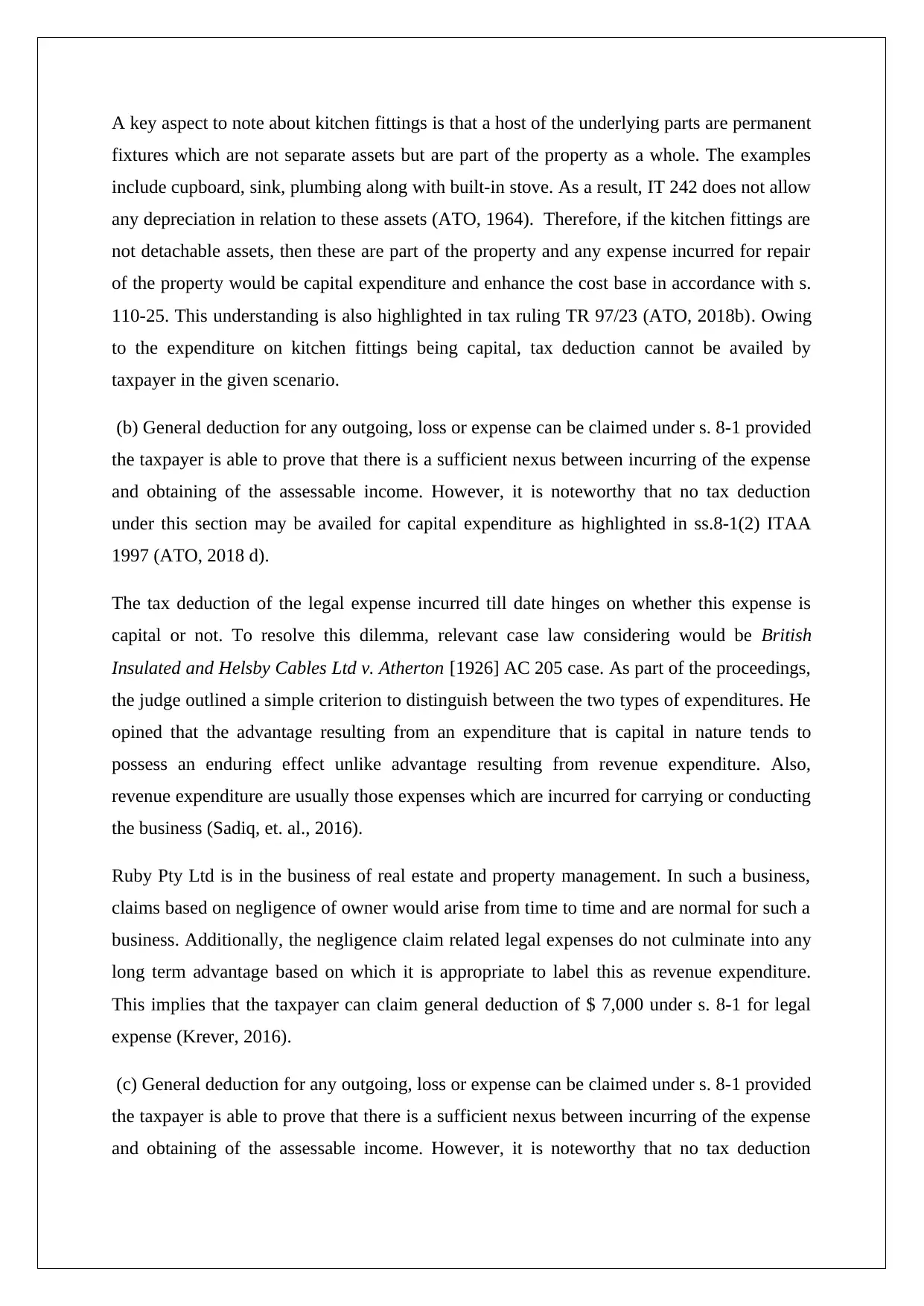
A key aspect to note about kitchen fittings is that a host of the underlying parts are permanent
fixtures which are not separate assets but are part of the property as a whole. The examples
include cupboard, sink, plumbing along with built-in stove. As a result, IT 242 does not allow
any depreciation in relation to these assets (ATO, 1964). Therefore, if the kitchen fittings are
not detachable assets, then these are part of the property and any expense incurred for repair
of the property would be capital expenditure and enhance the cost base in accordance with s.
110-25. This understanding is also highlighted in tax ruling TR 97/23 (ATO, 2018b). Owing
to the expenditure on kitchen fittings being capital, tax deduction cannot be availed by
taxpayer in the given scenario.
(b) General deduction for any outgoing, loss or expense can be claimed under s. 8-1 provided
the taxpayer is able to prove that there is a sufficient nexus between incurring of the expense
and obtaining of the assessable income. However, it is noteworthy that no tax deduction
under this section may be availed for capital expenditure as highlighted in ss.8-1(2) ITAA
1997 (ATO, 2018 d).
The tax deduction of the legal expense incurred till date hinges on whether this expense is
capital or not. To resolve this dilemma, relevant case law considering would be British
Insulated and Helsby Cables Ltd v. Atherton [1926] AC 205 case. As part of the proceedings,
the judge outlined a simple criterion to distinguish between the two types of expenditures. He
opined that the advantage resulting from an expenditure that is capital in nature tends to
possess an enduring effect unlike advantage resulting from revenue expenditure. Also,
revenue expenditure are usually those expenses which are incurred for carrying or conducting
the business (Sadiq, et. al., 2016).
Ruby Pty Ltd is in the business of real estate and property management. In such a business,
claims based on negligence of owner would arise from time to time and are normal for such a
business. Additionally, the negligence claim related legal expenses do not culminate into any
long term advantage based on which it is appropriate to label this as revenue expenditure.
This implies that the taxpayer can claim general deduction of $ 7,000 under s. 8-1 for legal
expense (Krever, 2016).
(c) General deduction for any outgoing, loss or expense can be claimed under s. 8-1 provided
the taxpayer is able to prove that there is a sufficient nexus between incurring of the expense
and obtaining of the assessable income. However, it is noteworthy that no tax deduction
fixtures which are not separate assets but are part of the property as a whole. The examples
include cupboard, sink, plumbing along with built-in stove. As a result, IT 242 does not allow
any depreciation in relation to these assets (ATO, 1964). Therefore, if the kitchen fittings are
not detachable assets, then these are part of the property and any expense incurred for repair
of the property would be capital expenditure and enhance the cost base in accordance with s.
110-25. This understanding is also highlighted in tax ruling TR 97/23 (ATO, 2018b). Owing
to the expenditure on kitchen fittings being capital, tax deduction cannot be availed by
taxpayer in the given scenario.
(b) General deduction for any outgoing, loss or expense can be claimed under s. 8-1 provided
the taxpayer is able to prove that there is a sufficient nexus between incurring of the expense
and obtaining of the assessable income. However, it is noteworthy that no tax deduction
under this section may be availed for capital expenditure as highlighted in ss.8-1(2) ITAA
1997 (ATO, 2018 d).
The tax deduction of the legal expense incurred till date hinges on whether this expense is
capital or not. To resolve this dilemma, relevant case law considering would be British
Insulated and Helsby Cables Ltd v. Atherton [1926] AC 205 case. As part of the proceedings,
the judge outlined a simple criterion to distinguish between the two types of expenditures. He
opined that the advantage resulting from an expenditure that is capital in nature tends to
possess an enduring effect unlike advantage resulting from revenue expenditure. Also,
revenue expenditure are usually those expenses which are incurred for carrying or conducting
the business (Sadiq, et. al., 2016).
Ruby Pty Ltd is in the business of real estate and property management. In such a business,
claims based on negligence of owner would arise from time to time and are normal for such a
business. Additionally, the negligence claim related legal expenses do not culminate into any
long term advantage based on which it is appropriate to label this as revenue expenditure.
This implies that the taxpayer can claim general deduction of $ 7,000 under s. 8-1 for legal
expense (Krever, 2016).
(c) General deduction for any outgoing, loss or expense can be claimed under s. 8-1 provided
the taxpayer is able to prove that there is a sufficient nexus between incurring of the expense
and obtaining of the assessable income. However, it is noteworthy that no tax deduction
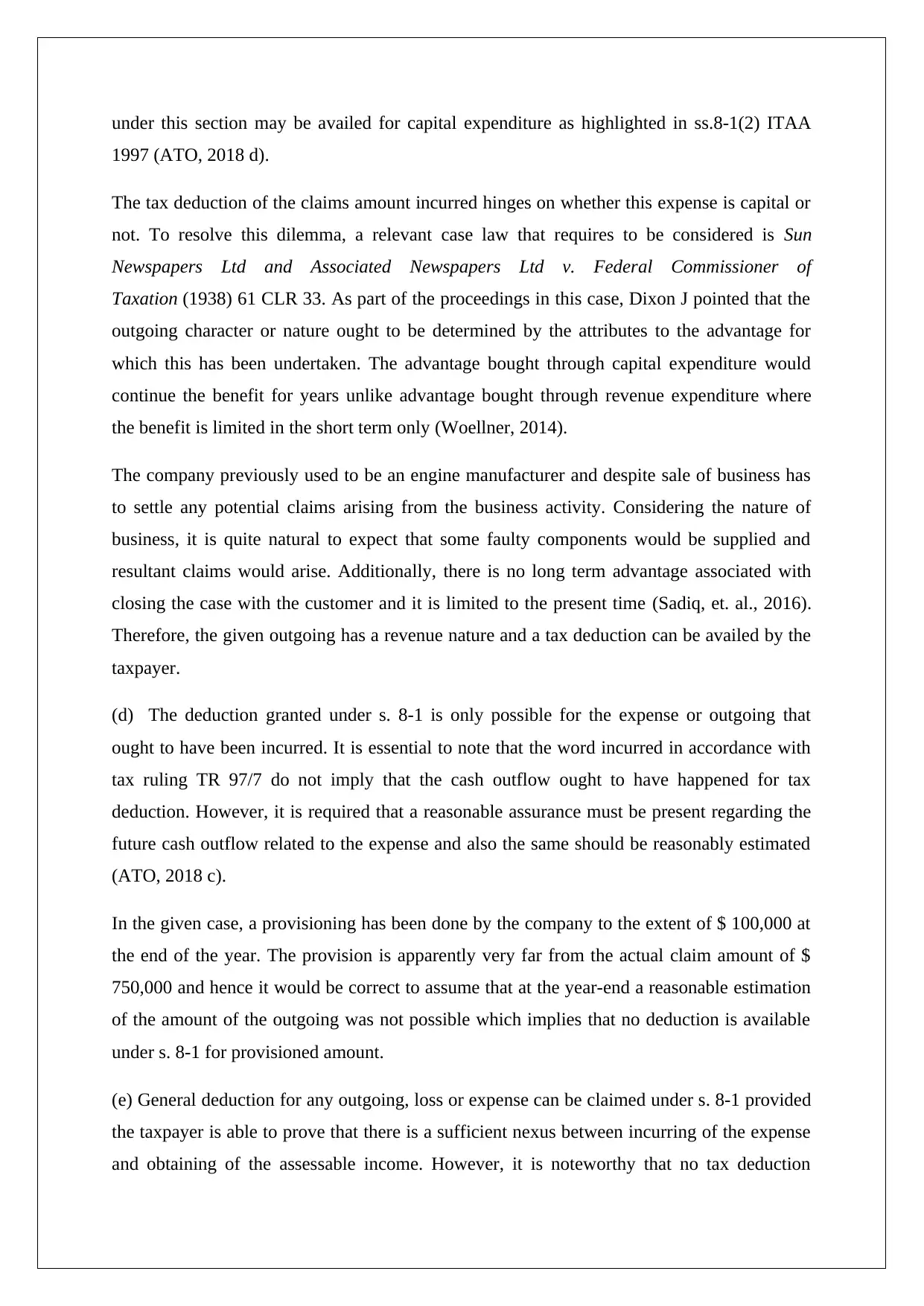
under this section may be availed for capital expenditure as highlighted in ss.8-1(2) ITAA
1997 (ATO, 2018 d).
The tax deduction of the claims amount incurred hinges on whether this expense is capital or
not. To resolve this dilemma, a relevant case law that requires to be considered is Sun
Newspapers Ltd and Associated Newspapers Ltd v. Federal Commissioner of
Taxation (1938) 61 CLR 33. As part of the proceedings in this case, Dixon J pointed that the
outgoing character or nature ought to be determined by the attributes to the advantage for
which this has been undertaken. The advantage bought through capital expenditure would
continue the benefit for years unlike advantage bought through revenue expenditure where
the benefit is limited in the short term only (Woellner, 2014).
The company previously used to be an engine manufacturer and despite sale of business has
to settle any potential claims arising from the business activity. Considering the nature of
business, it is quite natural to expect that some faulty components would be supplied and
resultant claims would arise. Additionally, there is no long term advantage associated with
closing the case with the customer and it is limited to the present time (Sadiq, et. al., 2016).
Therefore, the given outgoing has a revenue nature and a tax deduction can be availed by the
taxpayer.
(d) The deduction granted under s. 8-1 is only possible for the expense or outgoing that
ought to have been incurred. It is essential to note that the word incurred in accordance with
tax ruling TR 97/7 do not imply that the cash outflow ought to have happened for tax
deduction. However, it is required that a reasonable assurance must be present regarding the
future cash outflow related to the expense and also the same should be reasonably estimated
(ATO, 2018 c).
In the given case, a provisioning has been done by the company to the extent of $ 100,000 at
the end of the year. The provision is apparently very far from the actual claim amount of $
750,000 and hence it would be correct to assume that at the year-end a reasonable estimation
of the amount of the outgoing was not possible which implies that no deduction is available
under s. 8-1 for provisioned amount.
(e) General deduction for any outgoing, loss or expense can be claimed under s. 8-1 provided
the taxpayer is able to prove that there is a sufficient nexus between incurring of the expense
and obtaining of the assessable income. However, it is noteworthy that no tax deduction
1997 (ATO, 2018 d).
The tax deduction of the claims amount incurred hinges on whether this expense is capital or
not. To resolve this dilemma, a relevant case law that requires to be considered is Sun
Newspapers Ltd and Associated Newspapers Ltd v. Federal Commissioner of
Taxation (1938) 61 CLR 33. As part of the proceedings in this case, Dixon J pointed that the
outgoing character or nature ought to be determined by the attributes to the advantage for
which this has been undertaken. The advantage bought through capital expenditure would
continue the benefit for years unlike advantage bought through revenue expenditure where
the benefit is limited in the short term only (Woellner, 2014).
The company previously used to be an engine manufacturer and despite sale of business has
to settle any potential claims arising from the business activity. Considering the nature of
business, it is quite natural to expect that some faulty components would be supplied and
resultant claims would arise. Additionally, there is no long term advantage associated with
closing the case with the customer and it is limited to the present time (Sadiq, et. al., 2016).
Therefore, the given outgoing has a revenue nature and a tax deduction can be availed by the
taxpayer.
(d) The deduction granted under s. 8-1 is only possible for the expense or outgoing that
ought to have been incurred. It is essential to note that the word incurred in accordance with
tax ruling TR 97/7 do not imply that the cash outflow ought to have happened for tax
deduction. However, it is required that a reasonable assurance must be present regarding the
future cash outflow related to the expense and also the same should be reasonably estimated
(ATO, 2018 c).
In the given case, a provisioning has been done by the company to the extent of $ 100,000 at
the end of the year. The provision is apparently very far from the actual claim amount of $
750,000 and hence it would be correct to assume that at the year-end a reasonable estimation
of the amount of the outgoing was not possible which implies that no deduction is available
under s. 8-1 for provisioned amount.
(e) General deduction for any outgoing, loss or expense can be claimed under s. 8-1 provided
the taxpayer is able to prove that there is a sufficient nexus between incurring of the expense
and obtaining of the assessable income. However, it is noteworthy that no tax deduction
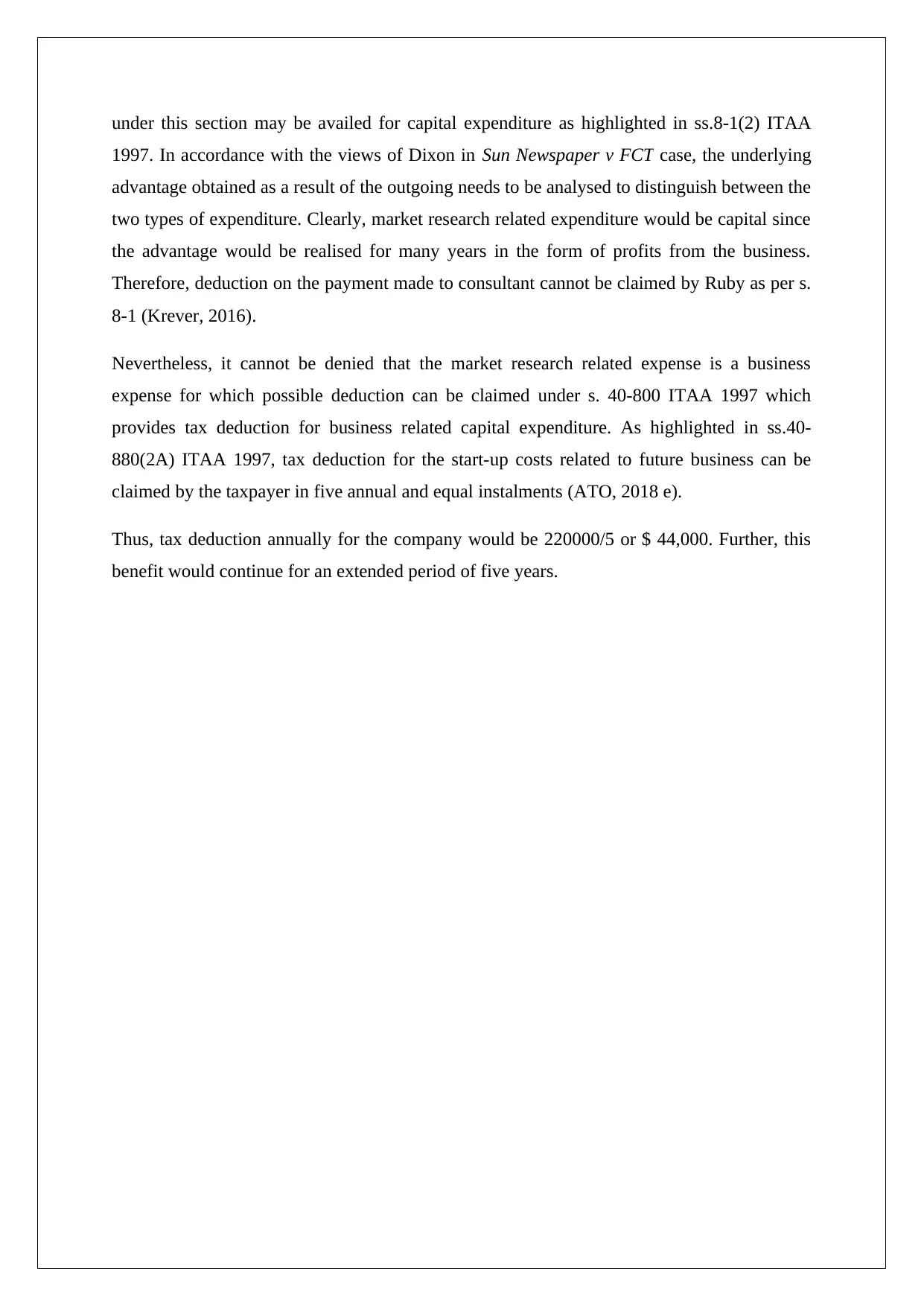
under this section may be availed for capital expenditure as highlighted in ss.8-1(2) ITAA
1997. In accordance with the views of Dixon in Sun Newspaper v FCT case, the underlying
advantage obtained as a result of the outgoing needs to be analysed to distinguish between the
two types of expenditure. Clearly, market research related expenditure would be capital since
the advantage would be realised for many years in the form of profits from the business.
Therefore, deduction on the payment made to consultant cannot be claimed by Ruby as per s.
8-1 (Krever, 2016).
Nevertheless, it cannot be denied that the market research related expense is a business
expense for which possible deduction can be claimed under s. 40-800 ITAA 1997 which
provides tax deduction for business related capital expenditure. As highlighted in ss.40-
880(2A) ITAA 1997, tax deduction for the start-up costs related to future business can be
claimed by the taxpayer in five annual and equal instalments (ATO, 2018 e).
Thus, tax deduction annually for the company would be 220000/5 or $ 44,000. Further, this
benefit would continue for an extended period of five years.
1997. In accordance with the views of Dixon in Sun Newspaper v FCT case, the underlying
advantage obtained as a result of the outgoing needs to be analysed to distinguish between the
two types of expenditure. Clearly, market research related expenditure would be capital since
the advantage would be realised for many years in the form of profits from the business.
Therefore, deduction on the payment made to consultant cannot be claimed by Ruby as per s.
8-1 (Krever, 2016).
Nevertheless, it cannot be denied that the market research related expense is a business
expense for which possible deduction can be claimed under s. 40-800 ITAA 1997 which
provides tax deduction for business related capital expenditure. As highlighted in ss.40-
880(2A) ITAA 1997, tax deduction for the start-up costs related to future business can be
claimed by the taxpayer in five annual and equal instalments (ATO, 2018 e).
Thus, tax deduction annually for the company would be 220000/5 or $ 44,000. Further, this
benefit would continue for an extended period of five years.
Paraphrase This Document
Need a fresh take? Get an instant paraphrase of this document with our AI Paraphraser
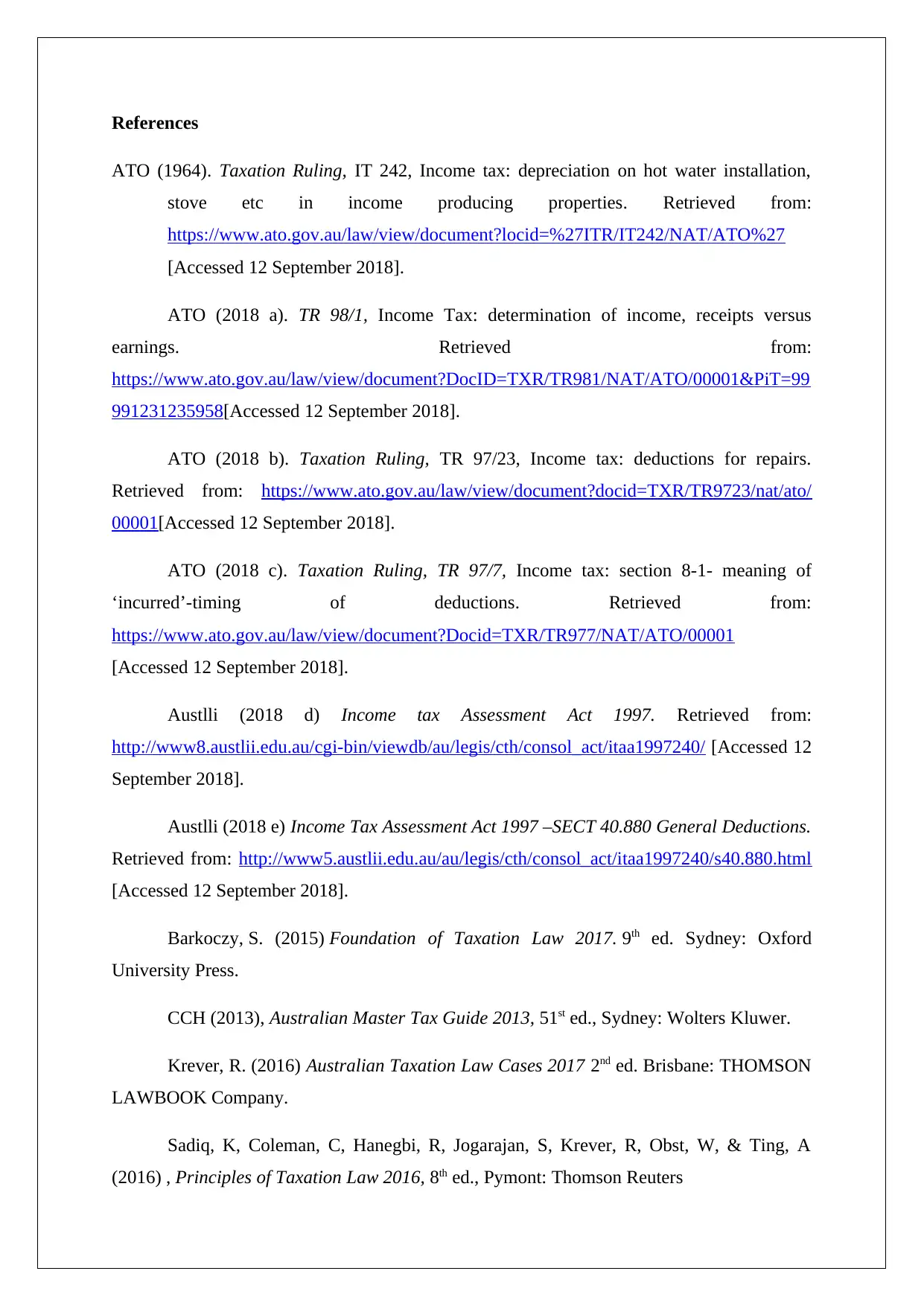
References
ATO (1964). Taxation Ruling, IT 242, Income tax: depreciation on hot water installation,
stove etc in income producing properties. Retrieved from:
https://www.ato.gov.au/law/view/document?locid=%27ITR/IT242/NAT/ATO%27
[Accessed 12 September 2018].
ATO (2018 a). TR 98/1, Income Tax: determination of income, receipts versus
earnings. Retrieved from:
https://www.ato.gov.au/law/view/document?DocID=TXR/TR981/NAT/ATO/00001&PiT=99
991231235958[Accessed 12 September 2018].
ATO (2018 b). Taxation Ruling, TR 97/23, Income tax: deductions for repairs.
Retrieved from: https://www.ato.gov.au/law/view/document?docid=TXR/TR9723/nat/ato/
00001[Accessed 12 September 2018].
ATO (2018 c). Taxation Ruling, TR 97/7, Income tax: section 8-1- meaning of
‘incurred’-timing of deductions. Retrieved from:
https://www.ato.gov.au/law/view/document?Docid=TXR/TR977/NAT/ATO/00001
[Accessed 12 September 2018].
Austlli (2018 d) Income tax Assessment Act 1997. Retrieved from:
http://www8.austlii.edu.au/cgi-bin/viewdb/au/legis/cth/consol_act/itaa1997240/ [Accessed 12
September 2018].
Austlli (2018 e) Income Tax Assessment Act 1997 –SECT 40.880 General Deductions.
Retrieved from: http://www5.austlii.edu.au/au/legis/cth/consol_act/itaa1997240/s40.880.html
[Accessed 12 September 2018].
Barkoczy, S. (2015) Foundation of Taxation Law 2017. 9th ed. Sydney: Oxford
University Press.
CCH (2013), Australian Master Tax Guide 2013, 51st ed., Sydney: Wolters Kluwer.
Krever, R. (2016) Australian Taxation Law Cases 2017 2nd ed. Brisbane: THOMSON
LAWBOOK Company.
Sadiq, K, Coleman, C, Hanegbi, R, Jogarajan, S, Krever, R, Obst, W, & Ting, A
(2016) , Principles of Taxation Law 2016, 8th ed., Pymont: Thomson Reuters
ATO (1964). Taxation Ruling, IT 242, Income tax: depreciation on hot water installation,
stove etc in income producing properties. Retrieved from:
https://www.ato.gov.au/law/view/document?locid=%27ITR/IT242/NAT/ATO%27
[Accessed 12 September 2018].
ATO (2018 a). TR 98/1, Income Tax: determination of income, receipts versus
earnings. Retrieved from:
https://www.ato.gov.au/law/view/document?DocID=TXR/TR981/NAT/ATO/00001&PiT=99
991231235958[Accessed 12 September 2018].
ATO (2018 b). Taxation Ruling, TR 97/23, Income tax: deductions for repairs.
Retrieved from: https://www.ato.gov.au/law/view/document?docid=TXR/TR9723/nat/ato/
00001[Accessed 12 September 2018].
ATO (2018 c). Taxation Ruling, TR 97/7, Income tax: section 8-1- meaning of
‘incurred’-timing of deductions. Retrieved from:
https://www.ato.gov.au/law/view/document?Docid=TXR/TR977/NAT/ATO/00001
[Accessed 12 September 2018].
Austlli (2018 d) Income tax Assessment Act 1997. Retrieved from:
http://www8.austlii.edu.au/cgi-bin/viewdb/au/legis/cth/consol_act/itaa1997240/ [Accessed 12
September 2018].
Austlli (2018 e) Income Tax Assessment Act 1997 –SECT 40.880 General Deductions.
Retrieved from: http://www5.austlii.edu.au/au/legis/cth/consol_act/itaa1997240/s40.880.html
[Accessed 12 September 2018].
Barkoczy, S. (2015) Foundation of Taxation Law 2017. 9th ed. Sydney: Oxford
University Press.
CCH (2013), Australian Master Tax Guide 2013, 51st ed., Sydney: Wolters Kluwer.
Krever, R. (2016) Australian Taxation Law Cases 2017 2nd ed. Brisbane: THOMSON
LAWBOOK Company.
Sadiq, K, Coleman, C, Hanegbi, R, Jogarajan, S, Krever, R, Obst, W, & Ting, A
(2016) , Principles of Taxation Law 2016, 8th ed., Pymont: Thomson Reuters
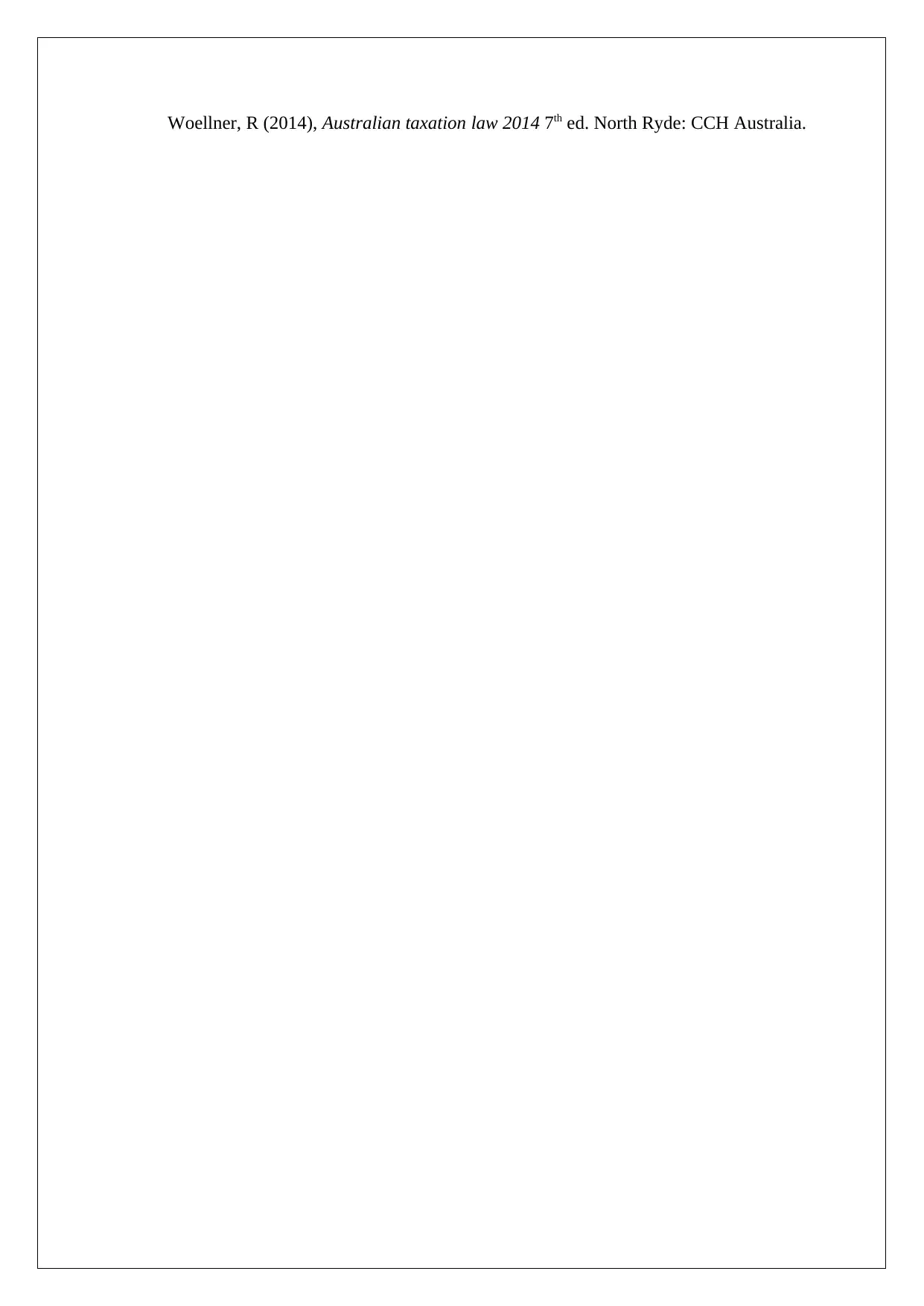
Woellner, R (2014), Australian taxation law 2014 7th ed. North Ryde: CCH Australia.
1 out of 9
Related Documents
Your All-in-One AI-Powered Toolkit for Academic Success.
+13062052269
info@desklib.com
Available 24*7 on WhatsApp / Email
![[object Object]](/_next/static/media/star-bottom.7253800d.svg)
Unlock your academic potential
© 2024 | Zucol Services PVT LTD | All rights reserved.





